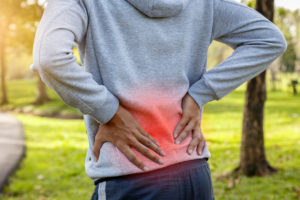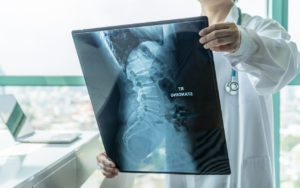
Back injuries are nearly universal. According to one study, between 50% and 80% of adults will experience back pain at some point during their lifetime. And among working-age Americans, 65 million people report experiencing back pain recently.
Back injuries have a major economic impact on the economy. They are the most common reason for missed workdays and cause more workers’ compensation claims than any other injury.
Read on to learn about back pain and the compensation you can seek for a back injury.
What is the Structure of Your Back?

This discussion will focus on the musculoskeletal structures in the back of your thorax and abdomen. This includes everything between your shoulders and hips that supports and moves your body.
Your spine runs down the center of your back. The average adult has 24 vertebrae in their spine. Each vertebra has a solid cylindrical body. The vertebral bodies align to form a column.
This column provides stability and flexibility in the back. The column supports your weight and gives you the leverage to lift and carry heavy objects. It also flexes and twists so you can bend over, look up, or turn your body.
Each vertebra has wind-shaped processes — which are bony projections. The spinous process provides anchor points for ligaments that hold the vertebrae together. They also anchor tendons that hold the back muscles to the spine.
The back includes some of the largest muscle groups in the body. Muscles in the back connect the spine, skull, shoulder blades, ribs, and pelvis. These muscles provide the strength to move your body and hold up your weight.
Ribs run from your spine around your sides to the front of your chest. Ligaments hold the ribs to joints in the spine. The ribs protect the vital organs in your thoracic cavity, including your heart, lungs, and major blood vessels.
Discs sit between the vertebrae. These discs cushion the vertebrae and provide a smooth surface on which the vertebrae move.
The discs have a composite structure to provide both toughness and flexibility. The tough outer layer, called the annulus, includes fibrous collagen. The gel-like interior, called the nucleus, includes a loose, jelly-like mixture of water and collagen fibers.
What Are Some Back Injury Examples?
Your back is a huge structure that can suffer many types of injuries, including:
Strains and Sprains
Your muscles, tendons, and ligaments consist of fibers. When they get hyperextended, they will stretch or tear. Hyperextension injuries can happen in any accident. For example, in a slip and fall accident, your body could twist as you fall. When you impact the ground, you could hyperextend your back.
Strains happen when the muscles or tendons of your back get stretched or torn. Muscles cover your entire back. They even sit between your ribs.
Some symptoms of a strained back include:
- Pain
- Swelling
- Muscle stiffness
- Muscle spasms
- Weakness
Sprains happen when ligaments in your spine get stretched or torn. You can sprain the ligaments holding your vertebrae together or the ligaments that hold your ribs to your spine.
Symptoms of a sprained back include:
- Pain
- Swelling
- Limited range of joint motion
- Bruises
- Popping sensation when you sprained your back
With rest, ice, and anti-inflammatory drugs, a minor strain or sprain will heal in four to six weeks. Doctors rarely operate to repair a strained or sprained back.
Dislocated Rib
Your ribs attach to your spine through ligaments. The rib can slip out of place when the ligaments stretch or tear.
Symptoms of a dislocated rib include:
- Pain that worsens when you inhale or exhale
- Swelling
- Redness
- Clicking or popping in your ribs when you injured your back
- Bump or protrusion in your back
Doctors will generally not operate to repair a dislocated rib. Instead, they will treat the inflammation so that the rib can slip back into place. They will usually prescribe rest, anti-inflammatory drugs, and physical therapy to strengthen the muscles around the joint.
Fractured Rib
Ribs can fracture when they get hit with a strong force. A fractured rib will usually heal in six to eight weeks with rest.
But fractured ribs can lead to other complications such as:
- A collapsed lung, if the broken end of the rib punctures the thoracic cavity
- Flail chest if the rib shatters into three or more pieces
These complications can cause death if the accident victim does not receive emergency treatment.
Damaged Disc
Forces on your spine can deform the discs between your vertebrae. The deformed disc can irritate nerves in your back or even compress your spinal cord.
If the damaged disc compresses the spinal cord, you can experience symptoms in your limbs such as:
- Radiating pain
- Numbness
- Tingling
- Loss of dexterity
- Loss of sensitivity to temperature and pressure
Car accidents involve forces that can damage discs. As your vehicle collides with something, your body wants to keep moving in the same direction at the same speed as before the collision. Your seat belt restrains your body, but your back will twist and bend before your body stops.
During this bending and twisting, your spine hyperextends. The vertebrae separate slightly. The ligaments pull your spine back together as you stop, and your spine compresses as it rebounds. This compression can crush your discs.
A herniated disc happens when the fibers of the annulus separate and allow the nucleus to protrude. A bulging disc happens when the annulus remains intact, but the compression causes the fibers to weaken. The weakened disc bulges into a barrel shape.
Fractured Vertebra
The force of an accident could fracture your vertebrae. The danger of a fractured vertebra is that the bone fragments could sever your spinal cord. If this happens, you will have permanent paralysis.
What Damages Can You Recover for a Back Injury?
You can seek compensation for your damages when you suffer a back injury due to someone else’s negligence.
Your damages include the financial costs of your back injury, including medical bills and lost income (economic damages). But more importantly, you can recover future financial costs such as diminished earning capacity if your back injury prevents you from working.
You can also seek compensation for your non-economic damages, such as the pain, mental anguish, and inconvenience you suffered.
Contact a Fort Walton Beach Personal Injury Lawyer for Help Recovering Compensation for a Back Injury
A serious back injury can diminish your quality of life and prevent you from earning a living. To discuss your back injury and the compensation you might recover from those who caused it, contact the Brannon & Brannon Car Accident & Personal Injury Lawyers for a free consultation.


